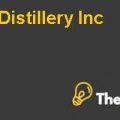
Q1: Briefly recap the history of Calaveras.
In the year 1883 Esteban Calaveras started the business of wine with the name of Calaveras Vineyards from the territory of Alameda Valley, California. Initially the business was serving Catholic Churches and by the passage of time in the year 1950 it expanded its operations and started to serve table wines to retailers and restaurants. Since the Calaveras Vineyards was a family owned business so it kept on changing hands and with an injection of new family generations Calaveras Vineyards kept on growing in the wine industry. Calaveras had divided its product range into three categories according to the quality of wine, further the wine was sold in five brand names. From the year 1987, Calaveras’ focus was on becoming a premium brand, company, hence, in order to successfully achieve the objective of this strategy, West-Coast marketer Winston Fendall was recruited into the company.
Its portfolio of products enabled Calaveras to segment the market in term of pricing and quality of the product, hence, improved quality up gradation of machinery enabled Calaveras to increase its prices from $29.52 in 1989 to $44.26 in 1993. Meanwhile, the despite several changes in ownership of family owned business Calaveras managed to achieve growth. Calaveras have its own fields that produced different variety and quality of grapes that enabled the production of different quality of grapes, meanwhile, its own grape fields enabled Calaveras to control the quality and per acre of land and the winery, the production facility and packaging facility were built at the vineyard. Although the existing capacity was adequate to meet the existing demand, however, it had taken out a moderate amount of area on lease for the storage of wines.
Q2: The new marketing company plans to collect Account Receivable and remit payment to Calaveras. Briefly discuss which company has responsibility for unpaid receivables after 90 days and why.
Winston-Fendall is basically a marketing company, but, meanwhile, it would have entered into such arrangements with Calaveras that Winston-Fendall will collect all the receivables of Calaveras and would remit the same to Calaveras. However, this arrangement will mean that Winston-Fendall is also a factoring company and the terms of the arrangement state that if in case Winston-Fendall fails to collect all the receivables of Calaveras within the 90 day period then Winston-Fendall would be liable to pay the entire outstanding receivables to Calaveras. Furthermore, the clause used in the arrangement is that Winston-Fendall would be responsible for the collection of Calaveras’ receivables on a non-recourse basis, which means that the factoring would unsecured and, however, in case if the customers of Calaveras do not pay the debts to Winston-Fendall, then Calaveras would not be responsible to compensate for the amount not paid by its customers.
However, this arrangement would enable Calaveras in order to transfer the credit risk but, meanwhile, outsourcing of receivables might discourage its loyal customers because the factoring company, which is Winston-Fendall in this case, would force the debtor to pay off its debts and factoring company might adopt an inappropriate behavior for timely collection of Calaveras’ receivables.
Q3: Calculate free cash flow for 1994-1998 using projections in the case with the adjustments that Anne Clemens is recommending.
Cash flow projection has been prepared using the projected financial statements over the five year period from 1994 to 1998; meanwhile, the adjustments have also been made regarding the capital expenditure that would be required to expand the production capacity so that the future projected sales volume can be produced. Further, the term loan will be repaid in five years’ time and, hence, the effect of cash flow on repayment of term loan has also been incorporated.
However, the projected cash flows show that during the first years’ projection of the cash flows would be negative by $407,100/- similarly in the next year cash flows would remain negative, but the magnitude will be reduced to $41,450/- of negative cash flows. However, from the third year the projected cash flows would turn to be positive and would remain positive thereafter for the rest of three years.
Q4: What discount rate would you recommend for valuing Calaveras and why? Show your calculation and support your assumptions.
The discount rate is used to incorporate the risk associated with the proposed investment and in case of Calaveras the invested amount is exposed to the operational risk which is measured in term of cost of equity, meanwhile, the financial risk is a measure of the cost of debt. Therefore, for the purpose of evaluation of the future projected cash flows of Calaveras the cost of equity has been calculated using the capital asset pricing model and this model uses the beta values, risk free rate, and market return on equity investment. However, beta represents the industry specific risk, hence, in order to incorporate the industry .................
This is just a sample partial case solution. Please place the order on the website to order your own originally done case solution.












